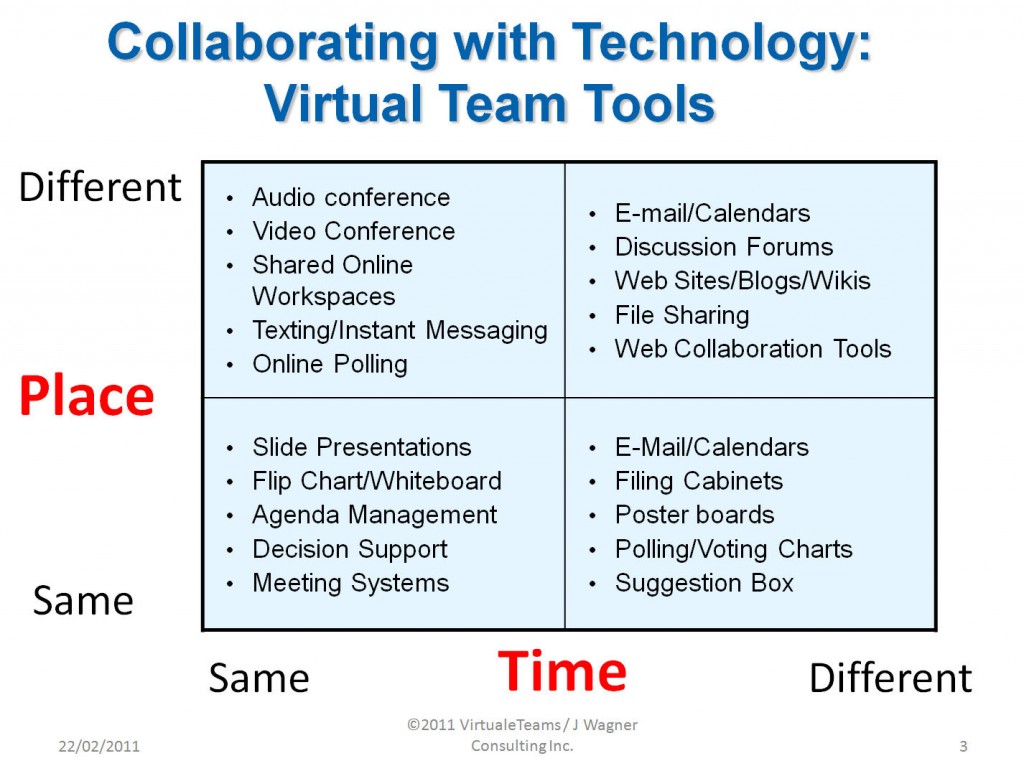Using Internet-based services to enable Virtual Teams and Blended Learning
The explosion in the development of powerful new computer-based and Internet-based tools and technologies in recent years has enabled organizations to successfully virtualize their teams and expand traditional learning approaches into Blended Learning systems which feature Virtual Classrooms.
We can categorize team collaboration and training as falling into four different quadrants as depicted in the diagram below. They are based on the dimensions of Time (participants are communicating at the same time or “synchronously” or at different times or “asynchronously”) and Place (participants are physically present in the same location or at different locations such as in the next office or across the globe)
Same place – same time
Teams have of course been collaborating and training in the same space at the same time for millenniums. Today, we do use technology-based tools to help these face-to-face meetings and trainings succeed. Products and services such as computer-driven slide presentations, electronic whiteboards and various software systems for agenda management, decision support, polling and brain storming are examples.
Same place – different time
Teams living in the same space need to collaborate and share information across time. In the past this was done primarily through paper-based records shared through storage in filing cabinets. Today, teams take advantage of technology-based tools to help store and share information across time. E-mail, calendaring systems and electronic data storage systems were early tools which significantly improved team productivity.
Different place – same time
Geographically dispersed teams naturally turn to technology-based tools to allow them to collaborate and train almost as effectively as they can do in person. Texting and instant messaging are also often used as well to communicate small amounts of information quickly. Web-based conferencing tools such as audio conferencing, video conferencing and workspace sharing allow for collaboration experiences which engage most of our senses and approximate a face-to-face meeting reasonably well. These same web-based conferencing tools are also great for virtual classroom delivery. Examples of three leading service providers in this area are Adobe Connect, Webex, GoToMeeting and ZOOM which offer rich online shared environments to support highly interactive collaborative team meetings and virtual classrooms. All of these service providers currently offer permanent free accounts (not trials) for you to explore.
Different place – different time
Virtual teams needing to communicate asynchronously can turn to additional technology-based services.
One of the most popular service offerings are discussion forums and groups which allow the creation of threads of discussions which persist through time and often provide a great source of knowledge to others who can search the archives of messages. Yahoo Groups was an early pioneer in providing such services with millions of groups being formed around the world to focus on topics of specific interest to it steam members. More recently, LinkedIn, a pioneer in providing networking services to professionals, has also developed a LinkedIn Groups service offering for networks or teams of people to establish private or public discussion groups. For example, the Organizational Development Network (ODNET), an association of OD professionals has established a discussion group with over 11,000 members. These discussion group technologies also provide the basis for Social Learning as part of Blended Learning systems by allowing dispersed groups of learners to learn from each other.
Also available online are more comprehensive collections of support services which provide more complete workspaces for teams to collaborate and train over time. One example is Huddle which provides shared calendars, file storage, task management, discussion groups and web-based conferencing services all from a simple desktop interface.
Which technology service to use?
This is often a difficult question to answer as the number of choices is growing at a phenomenal rate and the winners in the marketplace are not always obvious. We at VirtualeTeams can help you select the most appropriate services to meet your needs.
Contact us to explore what we can do for you!

